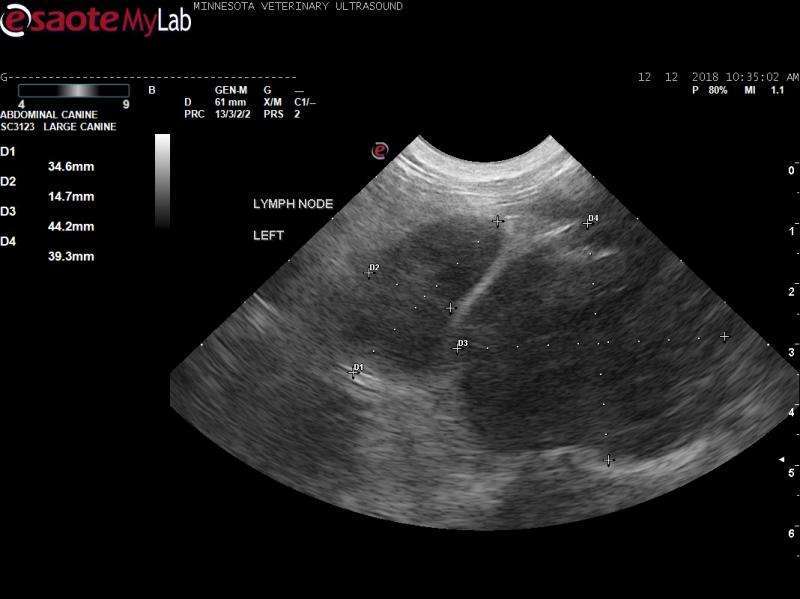– 3 year old intact male Golden Retreiver who lives in a rural area presented for a chronic rear leg lameness that suddenly became acutely painful
-PE showed a painful caudal abdomen and palpable caudal abdominal mass
-Radiographs showed a soft tissue density in the caudal abdomen causing ventral displacement of the colon. Radiographic images of the pelvis, femurs, and stifle joints were normal.
– 3 year old intact male Golden Retreiver who lives in a rural area presented for a chronic rear leg lameness that suddenly became acutely painful
-PE showed a painful caudal abdomen and palpable caudal abdominal mass
-Radiographs showed a soft tissue density in the caudal abdomen causing ventral displacement of the colon. Radiographic images of the pelvis, femurs, and stifle joints were normal.
-Abdominal ultrasound shows multiple, markedly enlarged sublumbar lymph nodes up to 5.2cm in diameter. They are rounded in countour with nodular parenchyma. Lymph node echogenicity is mixed, but overall hypoechoic to the surrounding fat. The prostate shows normal size (3.0cm) with normal uniform parenchyma. Echogenicity may be increased. The only mass I could readily palpate was actually the colon being displaced ventrally. The bladder was small with a normal wall and normal anechoic content.
-Ultrasound guided fine needle aspiration was performed and cytology is pending. I had to use a 20 gauge needle as the lymph nodes were quite firm. In-house cytology shows mostly lymphocytes with no evidence of neoplastic change (not basophilic, no blast cells seen, normal nuclear to cytoplasmic ratio, normal cytoplasm and nucleus). A few dividing cell were seen. Upon examination of a separate slide, my colleage also saw both intracellular and extracellular bacteria .
-My primary rule out was neoplasia based upon the large and abnormal appearance of the sublumbar lymph nodes (LSA, MCT). Now I am wondering what infectious disease could be causing this? Mycobacterial? Fungal? Brucellosis? Can acute prostatitis cause such large lymph nodes?


Comments
Based on cytology findings
Based on cytology findings you may want to try and get a culture.
Hard to believe the prostate is the source. Was there any other lymphadenopathy in the abdomen- or just sublumbar?
Just sublumbar. The rear leg
Just sublumbar. The rear leg lameness bothers me. The dog was examined by a mobile boarded surgeon who happened to be in the hospital the day before and he was unable to localize an orthopedic lesion based upon his PE.
Those lymph nodes sure do
Those lymph nodes sure do look lile they meet neoplastic criteria. There are signs of reactive / inflamed perilymphatic fat. Severe lymphadenitis would be the other DDx.
Yes a C/S would definitely be suggested pending cytology.
Anything abnormal on rectal palpation? Fever?
Any edema or signs of vasculitis in the rear legs? I would also consider full tick titers considering lameness although the lymphadenopathy is pretty severe.
I would rule out neoplasia first based on the cytology but biopsy of the LN may be needed. C/S of the tissue as well and go from there. If not neoplasia, bacteria, mycobacteria, fungal, and some other zebras are possible.
Thanks all! Will keep you
Thanks all! Will keep you posted on cytology results.
You can try fna again wiht
You can try fna again wiht 25g needle in variable echotextures of the mass. Using 25g usually gives better quality sample in case you used a 22g. Easy to core bx here as well.
The cytology report came back
The cytology report came back as “Highly necrotic tissue and poorly preserved mesenchymal-looking tissue, suspicious for mesenchymal cell neoplasia/spindle type sarcoma. The cellularity of intact cells is not sufficient for a confirmatory diagnosis. I see no recognizable lymphoid tissue to confirm a lymph node that is infiltrated by neoplastic tissue. Because spindle type neoplasms do not usually spread to lymph nodes, this could be a retroperitoneal sarcoma. Most of the sample was very necrotic and multiple Tru-Cut biopsies from different areas might be required to get a diagnostic and confirmatory sample. No obvious fungal or mycobacterial infection was seen.”
I am still convinced that these are sublumbar lymph nodes based upon their location. I am waiting to see if the clinic is willing to retry with core biopsies. Any other thoughts?
Thank Eric. I started off
Thank Eric. I started off with a 25 and then a 22, but had to move up to a 20 gauge needle due to the firmness of the nodes. The dog was referred to a specialty center and was diagnosed with a bone lesion in the right iliac wing, stongly suggestive of osteosarcoma. Sad (just a 3 year old Golden Retriever) but not suprising based upon the look of the nodes, the cytology report, and the history of a unilateral rear leg lameness.